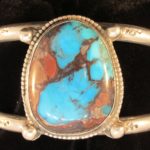Ironically, varieties of Bisbee Turquoise range from spiderweb to smoky and from blue to green. Additionally, the lavender/red host rock is a commonality, but the color of this turquoise can range in many different patterns and colors!

First of all, speckled varieties of Bisbee Turquoise are extremely rare. Consequently, the lavender host rock reveals small blue botryoidal nodules of Bisbee Turquoise. Remarkably, of all the Bisbee Turquoise that we buy and sell, this is the only example of this formation of turquoise that we have seen!

Secondly, this specimen is “Jelly Bean” Bisbee Turquoise. Notably, “Jelly Bean” has a gelatinous appearance. Most noteworthy, this variety of Bisbee turquoise has the translucent, pure blue quality of the stone. Consequently, we have a friend, Roger D., who says he has a strong desire to “eat” this variety of Bisbee turquoise! As a result, you can visualize how the copper solution flows through the host rock to form the turquoise that you see here.

Most noteworthy, this Bisbee turquoise is in it’s purist and most common form. Bisbee Turquoise has typical lavender host rock which encases blue turquoise. This is the typical pattern for Bisbee Turquoise to form. It is the only turquoise in the world which has this appearance. In contrast, sometimes people confuse the darker Bisbee Turquoise in darker host rock, for Persian Turquoise.
 In addition, this is what is people refer to as “Smoky Bisbee“. Incidentally, this is a light color for smoky, but the general characteristic of this variety of turquoise is “wispy” and is subtle in the host rock. Finally, the turquoise “wisps” throughout the host rock.
In addition, this is what is people refer to as “Smoky Bisbee“. Incidentally, this is a light color for smoky, but the general characteristic of this variety of turquoise is “wispy” and is subtle in the host rock. Finally, the turquoise “wisps” throughout the host rock.

Most notably, many people don’t realize that some varieties of Bisbee Turquoise can be green. Here it is along side Bisbee Turquoise that is blue. It is interesting to note that Green turquoise is a result of the mineral Iron present in the specimen. Blue turquoise is a result of the mineral copper in the specimen. It is our experience through Tucson Turquoise, that many more people prefer the blue color over the green color.

Additionally, Bisbee Turquoise can even form in Quartz! For example, this long cabochon exhibits the typical chocolate brown band of host rock along the top.
 Above all, when you see this turquoise, you know that it comes from only one place in the world. Furthermore, the lavender host rock is unmistakable. Certainly, to purchase genuine, authentic Bisbee Turquoise, please click HERE
Above all, when you see this turquoise, you know that it comes from only one place in the world. Furthermore, the lavender host rock is unmistakable. Certainly, to purchase genuine, authentic Bisbee Turquoise, please click HERE
 Finally, this ring came from the Viewpoint, Lavender Pit Shop at the rim of the Lavender Pit in Bisbee, Arizona. Most relevant, the shop would often use an “electro pen” to inscribe “Bisbee Blue.” The inscription is on the back of their jewelry. It serves as assurance that the piece came from them. Above all, back in the day certified Bisbee Turquoise was available right at the Bisbee Lavender Pit. Finally, the shop ceases operations, and is now in use for a different purpose.
Finally, this ring came from the Viewpoint, Lavender Pit Shop at the rim of the Lavender Pit in Bisbee, Arizona. Most relevant, the shop would often use an “electro pen” to inscribe “Bisbee Blue.” The inscription is on the back of their jewelry. It serves as assurance that the piece came from them. Above all, back in the day certified Bisbee Turquoise was available right at the Bisbee Lavender Pit. Finally, the shop ceases operations, and is now in use for a different purpose.